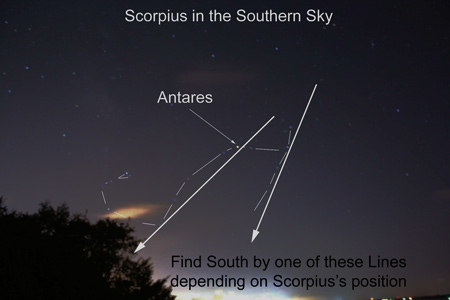Announcement: My online Land Navigation course includes four hours of video instruction, and two downloadable PDF books, all for about the same price as a typical paperback book. Get my Land Navigation course here.
The Scorpius Constellation

South by Scorpius
The Scorpius constellation is visible during the Northern Hemisphere's summer, which is the Southern Hemisphere's winter. The constellation's main star is Antares, a red giant that circles the earth at a latitude of around 26 degrees South. This means at that latitude Antares passes straight overhead. The farther north you are of that latitude, the lower Scorpius is in the sky. The same is true the farther south you are of that latitude.
Mythology
The mythology serves to help us remember the order of the night skies. It is said that Scorpius is chasing Orion, whom he will never catch since Orion is setting at about the time Scorpius is rising. As long as your feet are planted firmly on Earth, you'll never see fully Orion and Scorpius at the same time.
Scorpius's Place in the Sky
Mythology aside, the fact is that Scorpius is on the opposite side of the sun from Orion, which is why we never fully see them at the same time. We see Scorpius when the earth, in its annual orbit around the sun, is on the Scorpius side of the sun, and Orion when the earth is on Orion's side of the sun. The sun, of course, blocks out our view of any stars appearing on its far side.
Looks Like What It's Supposed To
Unlike some other constellations that don't readily appear like anything they're supposed to represent, Scorpius at least looks somewhat like a giant celestial scorpion. At its neck is the red giant star, Antares. Some people say Scorpius looks like a fishhook.
South by Scorpius
Like Orion, which rises on his back and sets on his stomach, Scorpius also shifts position as the night progresses. To find south by Scorpius, observe the constellation's position.
When the head is more or less vertical with the horizon, find south by way of an imaginary line drawn as straight as possible through the tail, and down to the horizon. When the tail is more or less vertical with the horizon, find south by way of an imaginary line drawn as straight as possible through the head, and down to the horizon.
These imaginary lines may not intersect with the horizon at exactly due south, buy they'll be plenty close enough to help you find your way to a lengthy baseline.

